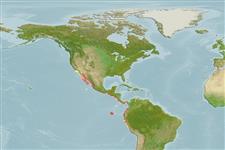Classification / Names
Common names from other countries
Main reference
Size / Weight / Age
Max length : 71.0 cm TL male/unsexed; (Ref. 40637); max. published weight: 13.0 kg (Ref. 40637)
Length at first maturity
Lm ?, range 19 - 20 cm
Environment
Marine; brackish; reef-associated; depth range 3 - 60 m (Ref. 9313)
Climate / Range
Subtropical, preferred 27°C (Ref. 107945); 36°N - 13°S, 120°W - 77°W (Ref. 55)
Distribution
Short description
Dorsal
spines
(total): 10;
Dorsal
soft rays
(total): 14;
Anal
spines: 3;
Anal
soft rays: 8. Forehead slopes steeply; snout somewhat pointed. Preopercular notch and knob weak. Scale rows on back parallel with lateral line. Rosy red anteriorly, becoming bright orange to yellow over most of the body; the fins are mainly yellow or orange; the inside of the mouth is white; a bluish horizontal streak runs below the eye.
IUCN Red List Status (Ref. 115185)
Threat to humans
Harmless
Human uses
Fisheries: commercial; aquaculture: experimental
More information
ReferencesAquacultureAquaculture profileStrainsGeneticsAllele frequenciesHeritabilityDiseasesProcessingMass conversion
Tools
Special reports
Download XML
Internet sources
Estimates of some properties based on models
Phylogenetic diversity index
PD50 = 0.5000 many relatives (e.g. carps) 0.5 - 2.0 few relatives (e.g. lungfishes)
Trophic Level
4.0 ±0.63 se; Based on food items.
Resilience
Low, minimum population doubling time 4.5 - 14 years (K=0.15;)
Vulnerability
High vulnerability (56 of 100)
Price category
